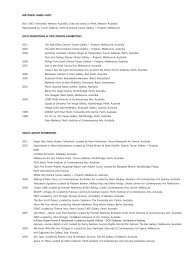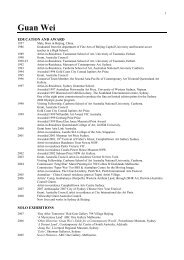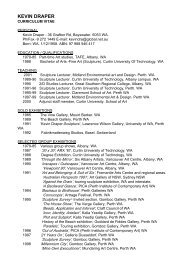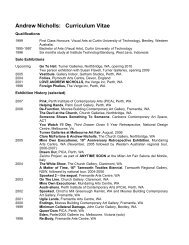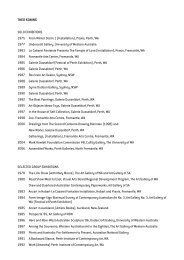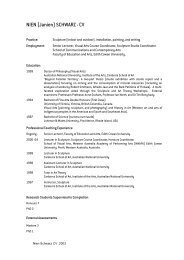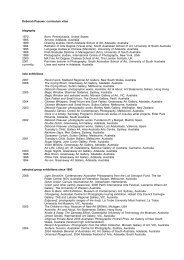to catch a herring catalogue - Turner Galleries
to catch a herring catalogue - Turner Galleries
to catch a herring catalogue - Turner Galleries
Create successful ePaper yourself
Turn your PDF publications into a flip-book with our unique Google optimized e-Paper software.
4much as theatrical deception for its effect. Yet if there is a tension betweenthose geometrically Pla<strong>to</strong>nic and the humanly desirable forms, its humour isdeepened by remoteness, the distance of the workshop from the bedroom.The titles put a similar distance between their meaning and what the workslook like.From The Last Leaf lets plunge a little deeper in<strong>to</strong> his<strong>to</strong>ry by considering theseissues from the angle of the impulse <strong>to</strong> show the back, as well as the front,of a canvas. One theory might be that <strong>to</strong> show the back of the canvas onthe front of the work of art projects an idea of <strong>to</strong>tal visibility in which the entirerealm of the visual comes within the artist’s reach, a form of <strong>to</strong>tal possession,<strong>to</strong>tal mastery, in whatever sense. Such an impulse might serve powerfulpropaganda needs when the patron enters the picture. Take what is perhapsthe most famous example of representation of the back of the canvas on thefront of the painting, Velazquez’s Las Meninas. So much ink has been spil<strong>to</strong>n so many interpretations of this painting that one trembles at the hubris ofattempting another, but, as far as the canvas is concerned, can one not saysome simple things that have not been said before? The artist stands proudlyin front of his canvas eyeing up his subjects on our side of the picture surface.Some say that we see that subject, the royal couple, reflected in a mirror atthe back of the hall. Measuring angles, however, mathematical scholars havetraced the image in the mirror <strong>to</strong> the image on Velazquez’s canvas in thepainting, whose surface we cannot see, except in the mirror. What we seeinstead is the whole drafty right-hand side of the back of the canvas, from ourpoint of view. Of course this isn’t the whole of the back of the canvas, but itpromises a fullness that the front of the real canvas, the one that still exists,seems <strong>to</strong> give us. For not only do we see the back of the canvas, we see thehandmaidens waiting on the royal Infanta, her dog, a court dwarf and otherofficials, including one who pauses with his foot on the doorway <strong>to</strong> the furtherworld beyond. From the point of view of court propaganda we are beingshown the loving and affectionate family circumstances within which the stiffroyal portrait is created. The back of the painting is a pledge of the love thatis passed off as the natural setting behind the monarchs’ public image. Whoknows whether this was true or not? It is what the raw back of the canvasleads us <strong>to</strong> suppose. But perhaps there’s more. From our point of view theartist is in front of his depicted canvas and we are behind it, but from hispoint of view is he not in some sense behind the real canvas that we see? Topaint it he must have been. One scholar has suggested that in this respectVelazquez might have been alluding <strong>to</strong> an ancient tradition about the backsof canvases. As Alberti, the Renaissance architect and theorist, reminded hisreader: ‘They say that Apelles hid behind a painting so that he could hear theirhonest opinions. Thus he heard how each one blamed or praised his work.Hence, I wish our painter openly <strong>to</strong> demand <strong>to</strong> hear each one who judgeshim. To the painter, all his merits were always known, and the things which hehas painted well are testimonies <strong>to</strong> his fame.’Velazquez was very proud of this painting for he painted an emblem of hisrise <strong>to</strong> higher rank as a red cross on his chest after its completion. With Paulthe reversal of the picture has as much of the comic as the magician about it,for he talks of his memories of the comic magician Tommy Cooper reversinghis illusion, accidentally on purpose, ‘Just like that!’ <strong>to</strong> show how it was done.Here his<strong>to</strong>rical slippage takes one from Velazquez’s court of seventeenthcenturySpain <strong>to</strong> the artisan’s gallery of seventeenth-century Holland. I takeCornelius Norbertus Gijsbrechts’ Reverse side of a painting (1670) <strong>to</strong> bethe ground zero of the comic rather than the magical mode of reversedcanvases. It is a painting that represents nothing other than the completeback of a painting, and was designed <strong>to</strong> fool the eye. An entry on this picturefrom Norbert Schneider’s Still Life is worth quoting entire:Gijsbrechts’ betrisgertje is meant <strong>to</strong> lead the viewer astrayby thinking that he ought <strong>to</strong> turn the picture the right wayround. The scrap of paper with the number 36 on it gives theimpression that this deceptive illusionist painting is actuallymeant for sale. It is therefore likely that the painting was originallyput up at a sales exhibition as a practical joke. The saleabilitywhich is associated with the picture probably also explainswhy it appears so abstract. At first sight, the painting certainlyseems modern <strong>to</strong> <strong>to</strong>day’s viewer. However, it is not an abstractpainting like Malevich’s two-dimensional Suprematist colourconfigurations. The accurate rendering of the stretching frameand its borders, as well as the canvas, show that the basicintention is <strong>to</strong>tally different: it is meant <strong>to</strong> emphasise plasticity,thus functioning as a substitute for a real object.This opens a giddying perspective on Paul’s works, because his paintingsare not of the backs, but simply are the backs of paintings, manufactured,so he tells me, with as much, or as little, necessary care, as the backs of thepaintings whose fronts we see. A moot point with them though, is the sides ofthe canvases whose backs are reversed. These sides, he has decided afterlong deliberation, belong <strong>to</strong> the fronts rather than the backs of the paintings,and so are painted.If we think about the comic revelations of Gijsbrechts, Cooper and Hinchliffe- in no particular order - we might consider that their impulse is opposite <strong>to</strong>Velasquez’s. They expose the emptiness of artifice rather than its fullness. Itis the ethos of the workshop rather than the court, and Paul speaks with shypride of the way in which first one group of workmen, then a second largergroup, then a third larger still came <strong>to</strong> glimpse works like these when he wasmounting them in a high-rise office that they <strong>to</strong>o were helping <strong>to</strong> fit out. It wastheir attention <strong>to</strong> the skill and the deflationary joke about the skill that tickledhim. In returning <strong>to</strong> the question of which world(s) these works exist in, it is



